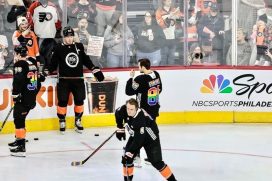Appropriate #TBT @NStauskas11? Some great foreshadowing right there! pic.twitter.com/lA5Ovxlaw7
— Peter Stauskas (@peterstauskas) July 2, 2015
Patrick Causey, on Twitter @PhillySportsJD
Now that the Sixers have officially acquired Nik Stauskas, let's break down what type of player Stauskas is and could become.
Heading into the 2014 NBA Draft, the Philadelphia 76ers had two draft picks, the third and tenth picks, to add to their young core of Nerlens Noel and Michael Carter-Williams.
According to Brett Brown, the Sixers thought they would come away with Andrew Wiggins and Nik Stauskas.
Brett Brown on Andrew Wiggins pre draft: "I thought we had him. I was expecting we were going to draft Stauskas and Wiggins." #Sixers
— Keith Pompey (@PompeyOnSixers) December 4, 2014
As it turned out, neither player was in the cards, and the Sixers ended up with Joel Embiid and Dario Saric instead.
Wiggins, as you know, went number one overall to the Cleveland Cavaliers before he was traded to the Minnesota Timberwolves, where he won rookie of the year and was named to the First Team All-NBA Rookie Team.
Stauskas was drafted — to the surprise of some — 8th overall by the Sacramento Kings. Stauskas largely struggled in his first year, averaging only 4 points a game on 36% shooting and 32% from beyond the arc. Not exactly inspiring numbers for a guy who was billed as a great shooter.
The Sixers tried to obtain the Kings 8th overall pick by offering the 10th pick in the draft along with two second rounders, presumably to draft Stauskas. The Kings turned that offer down so that they could take the sweet shooting guard from Michigan (go to 6:28 of the video to see the trade discussed):
This column isn't meant to be a discussion of how the Sixers fleeced the Kings in this trade (I already covered that here), but this clip is the perfect illustration of the problems with the Kings at an organizational level. Instead of getting a first round pick and two second rounders for the right to draft Stauskas, the Kings ended up trading this pick — just one year later — plus a future first and the right to swap two additional first round picks, all so that they could free up some cap space.
This lack of foresight and knee jerk reactionary nature of the Kings is managerial malpractice of the highest order, and explains why the Kings have not won more than 30 games since 2008.
Scouting Sauce Castillo
But I digress. Let's refocus on Nik Stauskas, the player the Sixers would have been thrilled to get in the draft last year.
In college, Stauskas developed a reputation as a good shooter with sneaky athleticism, a great handle, and the ability to get to the rim with ease. He was also considered a good passer, using his driving ability to draw in defenders and hit an teammate for an easy shot.
As you can see from the shooting chart below, Stauskas excelled from beyond the arc, especially at Sam Hinkie's favorite shot in the game: the corner three, where Stauskas shot an impressive 56.5%.
This chart also highlights shows how effective Stauskas was when attacking at the rim, where he shot 57%.
But as you see from the chart below, Stauskas struggled in his first season in the NBA, shooting a woeful 36% from the field and 32% from beyond the arc. Most concerning are his numbers on corner threes and at the rim, two areas which are traditionally high percentage shots in the NBA. Stauskas shot a combined 26.5% from corner threes and 46% at the rim.
While Stauskas was not very good last season, there were some extenuating circumstances that suggest we should take his struggles with a grain of salt.
Inconsistent minutes portends inconsistent play, and vice versa
For starters, the Sacramento Kings were a dumpster fire last year. The Kings went through three head coaches in one season: Michael Malone, Tyrone Corbin and George Karl. Adjusting to the NBA is tough enough for a rookie. Players are bigger, stronger, faster and much better than any competition a rookie has ever faced. Having a coaching change midseason makes it that much harder: you receive a new message, are asked to do new things, and have to learn a new system on the fly. But two coaching changes in your rookie year? That reason alone could have explained Stauskas' struggles.
But that wasn't the only problem. Stauskas's minutes were also wildly inconsistent. While he averaged approximately 15 minutes per game, he did not actually play 15 minutes on a consistent basis.
Look at this chart comparing Stauskas playing time to other NBA rookies last season (taken from the months of January and February):
|
Nik Stauskas |
Nerlens Noel |
Andrew Wiggins |
Dante Exum |
Marcus Smart |
|
12 |
22 |
40 |
22 |
28 |
|
16 |
34 |
37 |
23 |
17 |
|
10 |
26 |
41 |
30 |
21 |
|
20 |
28 |
39 |
24 |
22 |
|
17 |
32 |
39 |
16 |
31 |
|
19 |
31 |
37 |
8 |
29 |
|
15 |
31 |
36 |
22 |
30 |
|
0 |
39 |
36 |
16 |
27 |
|
0 |
33 |
40 |
20 |
27 |
|
7 |
24 |
32 |
29 |
32 |
|
23 |
31 |
39 |
35 |
27 |
|
17 |
0 |
38 |
29 |
14 |
|
15 |
33 |
41 |
25 |
0 |
|
7 |
24 |
38 |
26 |
29 |
|
3 |
31 |
40 |
24 |
24 |
|
23 |
29 |
36 |
20 |
27 |
|
11 |
31 |
43 |
25 |
30 |
|
10 |
29 |
43 |
28 |
37 |
|
3 |
33 |
37 |
34 |
41 |
|
9 |
27 |
43 |
33 |
37 |
|
0 |
26 |
39 |
26 |
36 |
|
14 |
34 |
37 |
20 |
26 |
|
0 |
32 |
38 |
21 |
36 |
|
0 |
33 |
37 |
19 |
31 |
|
|
35 |
41 |
19 |
24 |
|
|
31 |
36 |
12 |
30 |
|
|
30 |
33 |
|
31 |
|
|
34 |
42 |
|
|
As you can see, Stauskas' minutes, especially when compared to his contemporaries, were wildly inconsistent last year. Part of that was because he played behind Ben McLemore, who plays the same position as Stauskas and was drafted 7th overall just two years before Stauskas' arrival. His other position, small forward, was occupied by high priced veteran Rudy Gay.
Stauskas struggled to find consistent minutes, which likely led to his inconsistent play, which in turn led to less playing time. This was especially problematic for a shooter like Stauskas, who needs regular minutes to adjust to the speed and length of the NBA and improve his shot. It was a vicious cycle that fed off one another and could only be broken by a coach willing to stick with Stauskas and let him work through his growing pains.
Initially, George Karl did not provide the consistency that Stauskas needed for his play to his improve. But the minutes finally came, and Stauskas responded by shooting 42% behind the arc since the all-star break, good for 10th best in the league. And in March, Stauskas best month as a pro by far, he shot 47% from three, which would have been third best in the league for the year.
Stauskas acknowledged that playing for Karl impacted his game: "I played by best under (Karl). I like his style. He likes to get up and down, and he loves the three ball, which obviously works in my favor," Stauskas said. "I just need to be able to knock it down consistently. I'm looking forward to coming into next season."
Brett Brown runs a similar style offense, predicated on speed, ball movement, and three point shooting. Given the lack of quality options in front of Stauskas at the two guard, it is reasonable to expect that he will be given every opportunity to succeed. And given the improvement he showed at the tail end of last season, it is equally reasonable to assume that he plays well next year for the Sixers.
Exercise in futility: deriving a suitable NBA comparison for Stauskas
NBA comparisons for draft prospects and young players make it easy for fans to identify the type of player they can expect. But they can be awfully misleading. While players share similarities in their style of play, they are individual human beings that have meaningful differences in their personality, work ethics, and overall games. So every NBA comparison you see should be taken with a grain of salt.
With that out of the way, let's try to find a suitable NBA comparison for Stauskas.
I see Stauskas' floor as J.J. Reddick, and his proverbial ceiling as Klay Thompson. It's not a perfect comparison, especially since Reddick is two inches smaller that Stauskas. But all three players had similar games coming out of college: they were consider sharp shooters with limited athleticism that struggled on the defensive side of the ball.
Thompson was the trendy comparison for Stauskas last year leading up to the draft. But there are differences in their games that make the comparison seem somewhat unattainable. For starters, Thompson was a little taller, longer and better conditioned than Stauskas.
- Stauskas is 6'6.5 with shoes, 6'5.25 without.
- Thompson is 6'7.25 with shoes, 6'5.75 without.
- Stauskas has a 6'7.75 wingspan and 8'6 standing reach
- Thompson has a 6'9 wingspan and standing reach of 8'7.5.
- Stauskas had 12% body fat (an unusually high number for a two guard).
- Thompson had 8% body fat.
These differences seem minor, but they make a difference in the NBA, especially on the defensive side of the ball where a 6'9 wingspan is considered long for a shooting guard while a 6'7.75 wingspan is somewhat average.
Thompson was not always a great defender. In fact, coming out of college, he was considered a subpar standard like Stauskas. As his former coach Mark Jackson said:
"Klay has made himself a big-time defender. He does a great job of guarding the best perimeter guy on the other team. He has size, length and deceptive athletic ability. He pays attention to game-plan discipline, and he's able to get back into the picture with smaller guards and contest shots.
The amazing thing about it is that he didn't come into the league that way. It's awfully impressive the commitment he's made and how dedicated he is to being a big-time defender."
Stauskas did not play enough to show whether he will improve on the defensive side of the ball. It's certainly possible, but it should be noted that the type of improvement Thompson has shown on the defensive side of the ball is atypical. Most players can improve on their weaknesses; rarely do they turn those weaknesses into elite skills.
Which is why I think the Reddick comparison might be more realistic. Reddick was an incredible shooter in college, but was a limited athlete that lacked prototypical size and length to defend the two in the NBA. He struggled for his first four seasons in the NBA, averaging 6, 4.1, 6, and 9.6 points respectively before finally breaking into the double digit mark in 2010-2011. This was the result of Reddick dedicating himself to improving his fitness, and his play improved considerably as a result. In three of the last four seasons, Reddick has averaged at least 15 points while shooting 45% from the field, 50% from two, and 40% from three.
However, Reddick has never developed into a top flight defender, which should not come as a surprise given his size and athletic limitations. This is why Reddick has never become a star in the league.Reddick is a good starter for the Clippers, who are undoubtedly a championship caliber team. But given his defensive limitations, he will never be one of the guys on the team.
There is a chance Stauskas becomes a better version of Reddick, given that he is taller, longer, and considered a better ball handler than Reddick. But all things considered, if Stauskas becomes Reddick 2.0 it wouldn't be the worst thing in the world. The Sixers gave up next to nothing to acquire Stauskas, so if he turns into a long time starter for this team that provides much needed floor spacing for the Sixers collection of big men, then it is a great get.







